
Edited by: Dolors Manau - Assisted Human Reproduction Unit Institute of Gynecology, Spain
César Díaz García - IVIRMA London, UK
La preservación de la fertilidad por causa no médica o social es uno de los tratamientos reproductivos que ha experimentado mayor incremento de demanda en los últimos años. Es bien conocido el impacto de la edad en la reserva ovárica de la mujer y en la calidad ovocitaria. Esto impacta negativamente en las tasas de gestación espontánea, riesgo de aneuploidía, aborto y complicaciones maternas y fetales.
La criopreservación ovocitaria, llevada a cabo principalmente por una población sana, pretende mitigar el impacto de la edad en el envejecimiento ovárico y en las probabilidades futuras de gestación, aunque no se exime de otras consecuencias negativas a nivel de salud materna y fetal debido a un retraso de la maternidad.
Este manuscrito pretende revisar los pilares del tratamiento de congelación de óvulos en cuanto a eficacia, seguridad y coste-efectividad, ya que el incremento de demanda responde a un cambio de tendencia social y un incremento de mujeres que deciden posponer su maternidad, sobre todo por ausencia de pareja.
Asimismo, se hace hincapié en los aspectos éticos de un tratamiento, principalmente privatizado, al cual solo tiene acceso una minoría de la población y que además presenta ciertas limitaciones en mujeres que, a pesar de tener buen pronóstico reproductivo por edad, podrían encontrarse ya en situación de insuficiencia ovárica prematura.
Fertility preservation for social or non medical reasons is one of the reproductive treatments that has experienced the greatest increase in demand in recent years. The impact of age on a woman's ovarian reserve and oocyte quality is well known. This negatively impacts the rates of spontaneous pregnancy, risk of aneuploidy, miscarriage, and maternal and fetal complications.
Oocyte cryopreservation, carried out mainly by a healthy population, aims to mitigate the impact of age on ovarian aging and future chances of pregnancy, although it does not exempt itself from other negative consequences from the maternal and fetal health perspective, due to a delay in motherhood.
This manuscript aims to review the egg freezing treatment in terms of efficacy, safety and cost-effectiveness, since the increase in demand is an indirect reaction to a change in social trend and an increase in women who decide to postpone their motherhood, especially due to the absence of a partner.
It also emphasizes the ethical aspects of a treatment that only a minority of the population can benefit from due to its private access in most cases. This encounters certain limitations, especially for women who, despite having a good reproductive prognosis due to age, could already be in a situation of premature ovarian insufficiency.







